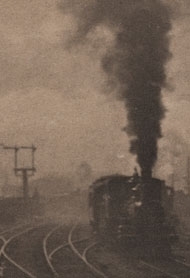Stieglitz Course Leads to Museum Exhibit

“Camera Work: Stieglitz, Steichen, Strand, and Company”
September 4—October 28, 2012
For immediate release: 8/1/12
For further information contact: Emmie Donadio, Chief Curator, at donadio@middlebury.edu or (802) 443-2240
Middlebury, VT—The Middlebury College Museum of Art will reopen on Tuesday, September 4, with a fall exhibition highlighting three luminaries of American photography: Alfred Stieglitz, Edward Steichen, and Paul Strand, along with lesser-known artists in their circle. Camera Work: Stieglitz, Steichen, Strand, and Company was organized for the museum by Charles A. Dana Professor of History of Art and Architecture Kirsten Hoving and students in her 2011 course “Camera Work: Alfred Stieglitz and Photography.” With more than twenty photogravures, the installation also includes issues of the pioneering journal Camera Work, which was published by Stieglitz between 1903 and 1917. Ultimately featuring articles on the revolutionary new art of European masters Rodin, Picasso, and Matisse, the publication was originally inaugurated by Stieglitz to demonstrate that photography was indeed a fine art, a goal it achieved through the reproduction of images by the most significant photographers of the day.
Responding to the emergence of haphazard snapshots created by vast numbers of amateur photographers using Kodak box cameras, Camera Work set a standard for photography as an art form by featuring portfolios of exquisitely printed photogravures. Each image was produced under the supervision of Stieglitz—or by the artist himself—by etching the photograph onto a copper plate, which was then inked and run through a printing press. While complete issues of the magazine are still in existence—and some libraries possess full sets of the publication—many more of them have been dismantled, with individual images appearing as unique prints for sale at auctions and online.
The photogravure process lent itself especially well to work in the pictorialist style popular at the turn of the century. Characterized by soft focus, delicate contrast, and distinctive painterly qualities, the images by Steichen and Stieglitz himself, among other artists in their circle, compare favorably with the style and sensibility of American painting of the same period. Thus were the photographers able to establish their images as works of art in their own right.
As European modernism came to the United States after the first decade of the century, Stieglitz turned his attention to newer styles of art. After the pictorialists, the final issues of Camera Work contained images by Paul Strand that demonstrated a brutally direct, unmanipulated or “straight” style of photography. These show the transition to a new style of vision, while yet maintaining the high standard of photogravure reproduction that the magazine had promoted.
Hoving will present an “Off the Wall” lecture-luncheon about the exhibition on Friday, September 28 beginning at 11:00 a.m., to which the public is invited. Middlebury students who worked with her to produce the exhibition were Grace Bell, Camilla Burchfield, Zachary Doleac, Erik Fendik, Robert Johnson, Zachary Karst, Rebecca Tharp, Nichole Wyndham, and Daisy Zhuo. The exhibition will remain on view through Sunday, October 28.
The Middlebury College Museum of Art, located in the Mahaney Center for the Arts on Rte. 30 on the southern edge of campus, is free and open to the public Tues. through Fri. from 10 a.m. to 5 p.m., and Sat. and Sun. from noon to 5 p.m. It is closed Mondays. The museum is physically accessible. Parking is available in the Mahaney Center for the Arts parking lot. For further information and to confirm dates and times of scheduled events, please call (802) 443–5007 or TTY (802) 443–3155, or visit the museum’s website at museum.middlebury.edu.
